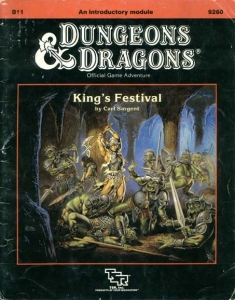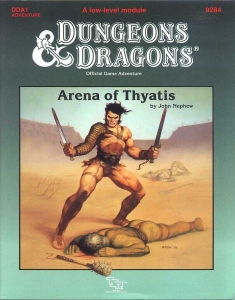
Ravenloft is an adventure module for the Dungeons & Dragons (D&D) fantasy role-playing game. The American game publishing company TSR, Inc. released it as a standalone adventure booklet in 1983 for use with the first edition Advanced Dungeons & Dragons game. It was written by Tracy and Laura Hickman, and includes art by Clyde Caldwell with maps by David Sutherland III. The plot of Ravenloft focuses on the villain Strahd von Zarovich, a vampire who pines for his lost love. Various story elements, including Strahd's motivation and the locations of magical weapons, are randomly determined by drawing cards. The player characters attempt to defeat Strahd and, if successful, the adventure ends.

The Lost Island of Castanamir (C3) is an adventure module written by Ken Rolston for the first edition of the Advanced Dungeons & Dragons fantasy roleplaying game. The adventure was published in 1984 by TSR. As part of the C(ompetition)-series of modules The Lost Island of Castanamir contains material first used as a tournament adventure. The adventure is intended for five to eight characters of level 1-4.

Scourge of the Slave Lords (A1–4) is an adventure module for the Dungeons & Dragons fantasy role-playing game, published by TSR, Inc. in 1986. It combines the contents of four earlier modules, all set in the World of Greyhawk campaign setting and intended for use with Advanced Dungeons & Dragons first edition rules.

Treasure Hunt is an adventure module for the Advanced Dungeons & Dragons (AD&D) role-playing game, written by Aaron Allston for the 1st edition Advanced Dungeons & Dragons (AD&D) rules. The player characters must evolve into their roles as the adventure progresses, beginning as slaves on a galley who become freed after a shipwreck on an island where orcs and goblins contend over a treasure. The adventure received a positive review from White Dwarf magazine.
The DL series is a series of adventures and some supplementary material for the Advanced Dungeons & Dragons role playing game. These modules along with the Dragonlance Chronicles trilogy of novels, which follow one possible adventure series through the modules, were the first published items that established the Dragonlance fictional universe. The original DL series was released from 1984 to 1986, with the final two modules added to it in 1988. In the 1990s these roleplaying adventures from the original series were collected and revised for 2nd Edition AD&D as the three DLC Dragonlance Classics modules. There were also versions of the module series released in 1999, 2000 and 2006.

Dragons of Desolation is the fourth and final module in the first major story arc in the Dungeons & DragonsDragonlance series of game modules. It is one of the fourteen Dragonlance adventures published by TSR between 1984 and 1986. The module is intended for player characters of level 6–8.

Swords of Deceit is a 1986 adventure module for the Advanced Dungeons & Dragons fantasy role-playing game, for the Lankhmar setting.

Rahasia is an adventure module, self-published by DayStar West Media in 1980 and published by TSR, Inc. in 1983 and 1984, for the Basic Set rules of the Dungeons & Dragons fantasy role-playing game. Its product designation is TSR 9115. It was designed by Tracy and Laura Hickman, and features artwork by Jeff Easley and Timothy Truman.

Desert of Desolation is a compilation adventure module published by TSR for the Dungeons & Dragons (D&D) fantasy roleplaying game. It combines three previously published individual modules: Pharaoh, Oasis of the White Palm, and Lost Tomb of Martek. The modules were made for use with the first edition Advanced Dungeons & Dragons (AD&D) rules. Pharaoh was created by Tracy and Laura Hickman soon after the couple married in 1977, and published by TSR in 1982. Oasis of the White Palm was a collaboration between Tracy Hickman and Philip Meyers, and Hickman wrote the Lost Tomb of Martek on his own; both were printed in 1983.

The Veiled Society is an adventure module for the Basic Rules of the Dungeons & Dragons fantasy role-playing game published in 1984. The adventure's product designation is TSR 9086.

Night's Dark Terror is an adventure module for the Dungeons & Dragons (D&D) fantasy role-playing game written by British game designers Jim Bambra, Graeme Morris, and Phil Gallagher. It was designed specifically for campaigns transitioning from the D&D Basic Set to the D&D Expert Set. The player characters (PCs) journey from a farmstead into uncharted wilderness, where they encounter new hazards and contend with a secret society. The adventure received a positive review from White Dwarf magazine.

King's Festival is an adventure module for the Dungeons & Dragons fantasy role-playing game.

Temple of Death is a Dungeons & Dragons adventure module designed by David Cook for use with the D&D Expert Set. It was written by David Cook and published by TSR, Inc. in 1983. The module is intended for player characters of levels 6-10.

Quagmire! is a 1984 adventure module for the Expert Rules of the Dungeons & Dragons fantasy role-playing game.

When a Star Falls is an adventure module for the first edition of the Dungeons & Dragons fantasy role-playing game published by TSR, Inc. in 1984. It was written by Graeme Morris and is intended for 6–10 player characters between levels 3–5.

Egg of the Phoenix is an adventure module published in 1987 for the Advanced Dungeons & Dragons fantasy role-playing game.

Puppets is an adventure module published by TSR in 1989 for the fantasy role-playing game Advanced Dungeons & Dragons.

Arena of Thyatis is an adventure module published in 1990 for the Dungeons & Dragons fantasy role-playing game. This module is linked with Legions of Thyatis.

Legions of Thyatis is an adventure module published in 1990 for the Dungeons & Dragons fantasy role-playing game.

Nightwatch in the Living City is an adventure for the 2nd edition of the Advanced Dungeons & Dragons fantasy role-playing game.



















